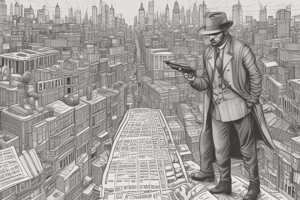Podcast
Questions and Answers
What is the main idea behind the Classical Theory of criminology?
What is the main idea behind the Classical Theory of criminology?
The main idea is that crime is a result of free will and rational choice, and that people choose to commit crimes because they believe the benefits outweigh the costs.
Who are the key figures associated with the Positivist Theory of criminology?
Who are the key figures associated with the Positivist Theory of criminology?
Cesare Lombroso and Enrico Ferri are the key figures associated with the Positivist Theory.
What is the main idea behind the Chicago School Theory of criminology?
What is the main idea behind the Chicago School Theory of criminology?
The main idea is that crime is a result of social disorganization and cultural deviance, and that urbanization and poverty lead to crime and delinquency.
What is the main idea behind the Conflict Theory of criminology?
What is the main idea behind the Conflict Theory of criminology?
Who is the key figure associated with the Labeling Theory of criminology?
Who is the key figure associated with the Labeling Theory of criminology?
What is the main idea behind the Control Theory of criminology?
What is the main idea behind the Control Theory of criminology?
What is the main idea behind the Routine Activities Theory of criminology?
What is the main idea behind the Routine Activities Theory of criminology?
Who are the key figures associated with the Rational Choice Theory of criminology?
Who are the key figures associated with the Rational Choice Theory of criminology?
How does the Positivist Theory of criminology differ from the Classical Theory?
How does the Positivist Theory of criminology differ from the Classical Theory?
What is the common theme among the Criminology Theories?
What is the common theme among the Criminology Theories?
Flashcards are hidden until you start studying
Study Notes
Criminology Theories
Classical Theory
- Focuses on the idea that crime is a result of free will and rational choice
- People choose to commit crimes because they believe the benefits outweigh the costs
- Emphasizes the importance of punishment as a deterrent
- Key figures: Cesare Beccaria, Jeremy Bentham
Positivist Theory
- Focuses on the idea that crime is a result of biological, psychological, or social factors
- Criminals are different from non-criminals due to factors such as genetics, upbringing, or environment
- Emphasizes the importance of rehabilitation and treatment
- Key figures: Cesare Lombroso, Enrico Ferri
Chicago School Theory
- Focuses on the idea that crime is a result of social disorganization and cultural deviance
- Urbanization and poverty lead to crime and delinquency
- Emphasizes the importance of community and social reform
- Key figures: Robert Park, Ernest Burgess, Robert Merton
Conflict Theory
- Focuses on the idea that crime is a result of social and economic inequality
- The wealthy and powerful create laws to maintain their power and control over the poor and marginalized
- Emphasizes the importance of social change and revolution
- Key figures: Karl Marx, Friedrich Engels, Richard Quinney
Labeling Theory
- Focuses on the idea that crime is a result of societal labeling and stigma
- People are labeled as deviant or criminal, and this label affects their behavior and self-identity
- Emphasizes the importance of understanding the social construction of crime
- Key figures: Howard Becker, Edwin Lemert, Kai Erikson
Control Theory
- Focuses on the idea that crime is a result of lack of social control and bonds
- People who are well-integrated into society and have strong social bonds are less likely to commit crimes
- Emphasizes the importance of socialization and social integration
- Key figures: Travis Hirschi, Michael Gottfredson
Routine Activities Theory
- Focuses on the idea that crime is a result of the convergence of motivated offenders, suitable targets, and the absence of capable guardians
- Emphasizes the importance of understanding the opportunities and circumstances that lead to crime
- Key figures: Marcus Felson, Lawrence Cohen
Rational Choice Theory
- Focuses on the idea that crime is a result of rational decision-making and cost-benefit analysis
- People choose to commit crimes because they believe the benefits outweigh the costs
- Emphasizes the importance of understanding the rational decision-making process of criminals
- Key figures: Derek Cornish, Ronald Clarke
Studying That Suits You
Use AI to generate personalized quizzes and flashcards to suit your learning preferences.




